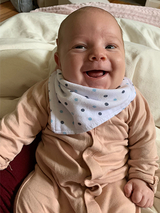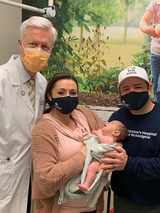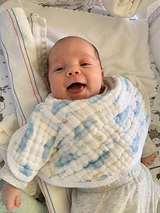Given’s Story: Prenatal Care and Postnatal Surgery for Sacrococcygeal Teratoma
Given’s Story: Prenatal Care and Postnatal Surgery for Sacrococcygeal Teratoma
Given’s dad, Garret, spent 16 years fundraising for children’s hospitals, never thinking that one day, he and his family would need the lifesaving care his efforts had supported all those years.

Garret and Agata were eager to learn they were expecting a boy. Things took a sudden turn when, at their 20-week anatomy scan with Penn Medicine, something appeared abnormal on the ultrasound.
“I couldn’t stop crying,” recalls Agata, a registered nurse who works at Penn Presbyterian Medical Center in Philadelphia.
The South Jersey couple was referred to Children’s Hospital of Philadelphia’s Richard D. Wood Jr. Center for Fetal Diagnosis and Treatment. The Center wasted no time, bringing them in for a comprehensive evaluation the next day. After a number of tests, the fetal diagnosis was confirmed to be a sacrococcygeal teratoma (SCT), a tumor that develops in the tailbone region. SCT’s are very rare in boys.
The Center’s Director of Fetal Imaging, Beverly G. Coleman, MD, a board-certified radiologist who specializes in prenatal imaging, performed a detailed scan of the fetus to clarify the severity of the diagnosis. That thorough imaging identified that it was a Type 1 SCT, which meant the tumor was completely outside the body.
At the end of the daylong evaluation, the couple met with members of the Center’s team. They discussed the plan to monitor the tumor’s growth every two weeks until planned delivery. Not long into that follow-up care, however, Agata began to experience pregnancy complications that put her at high risk for preterm labor.
“I was bleeding a lot,” says Agata. “We didn’t know if I was going to be able to carry the pregnancy.”
Support through a difficult journey
Agata was admitted to CHOP’s Garbose Family Special Delivery Unit (SDU) at 25 weeks’ gestation. She remained on bedrest to reduce the risks of the complications she was experiencing while the care team regularly monitored the fetus’s health.
It was a difficult journey — both physically and emotionally. There were several close calls for a very early delivery. The shared experience bonded the couple and their care team. Each time they overcame a hurdle together and were able to prolong the pregnancy just a bit longer, Garret ordered pizza and the entire unit celebrated.
The couple also felt support above and beyond their medical care. CHOP’s Child Life team learned the couple yearned to have maternity pictures, so they enlisted a photographer and organized the first-ever maternity photo shoot within the hospital. Over multiple sessions, a music therapist guided Agata and Garret through calming breathing techniques, helped them pick songs to play during the delivery, and helped them write a song for Given. Garret sang the song to Given through Agata’s stomach every day for the rest of the pregnancy.
Psychosocial Support Services in the CFDT and SDU
”It’s an amazing unit, and they are doing amazing work there,” says Garret, who as a leading fundraiser for Children’s Miracle Network (CMN) and an ambassador for CMN’s Torch Relay, knows a thing or two about the need for robust hospital services. “I love how CHOP cares for the mental side of things, too. The focus on the stress relief really carried us through. You don’t realize how much support you need. We were really thankful those services were offered.”
After five weeks in the SDU, Agata was transferred to the adjacent Hospital of the University of Pennsylvania (HUP), where she needed to deliver due to her high-risk complications.
From rough pregnancy to postnatal sacrococcygeal teratoma surgery

On Jan. 31, 2022, at 34 weeks’ gestation, Given was born in HUP and transferred to CHOP’s Harriet and Ronald Lassin Newborn/Infant Intensive Care Unit (N/IICU) via a walkway that connects the two hospitals. He weighed 5 lbs. The tumor took up 6 ounces alone.
Two days after the birth, world-renowned surgeon, fetal medicine pioneer and Center co-founder, N. Scott Adzick, MD, surgically removed the tumor and part of Given’s tailbone to decrease the risk of tumor recurrence. Given spent the next six weeks in the N/IICU. Initially, he struggled to breathe on his own and gain weight due to being born premature. Breathing and feeding tubes supported him until he got stronger and was able to do both on his own.
While Given was in the N/IICU, Garret and Agata either stayed in one of the unit’s sleep rooms or at a room in the nearby Ronald McDonald House. Collectively, the family spent more than 100 days in the hospital.
Home and happy

Since being discharged home, Given, now one, has “been doing phenomenal,” says his dad. His favorite things to do are cuddle with his parents, listen to music and stories, and smile. When Garret sings the song he and Agata wrote with CHOP’s music therapist, he sees a glint of recognition in his son’s eyes.
Given has follow-up assessments with an eye doctor and a kidney specialist due to his prematurity, and he’ll continue to be followed by CHOP oncologists for close monitoring of tumor markers and recurrence, but so far, so good.
“We’re really thankful,” says Garret. “We went through every scary scenario there could be. Now he’s passing his tests and follow-ups, and mom is doing well. We hope to inspire and help others going through what we did. We want to shed light on the amazing care, nurses, services, and our family of doctors at CHOP. Everything was perfect at CHOP, and we are very grateful. Both mom and baby had very rare conditions, and CHOP got us through.”